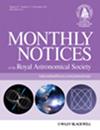Hot gas accretion fuels star formation faster than cold accretion in high redshift galaxies
IF 4.8
3区 物理与天体物理
Q1 ASTRONOMY & ASTROPHYSICS
引用次数: 0
Abstract
We use high-resolution (≃ 35pc) hydrodynamical simulations of galaxy formation to investigate the relation between gas accretion and star formation in galaxies hosted by dark matter haloes of mass 1012M⊙ at z = 2. At high redshift, cold-accreted gas is expected to be readily available for star formation, while gas accreted in a hot mode is expected to require a longer time to cool down before being able to form stars. Contrary to these expectations, we find that the majority of cold-accreted gas takes several hundred Myr longer to form stars than hot-accreted gas after it reaches the inner circumgalactic medium (CGM). Approximately 10 percnt of the cold-accreted gas flows rapidly through the inner CGM onto the galactic disc. The remaining 90 percnt is trapped in a turbulent accretion region that extends up to ∼50 per cent of the virial radius, from which it takes several hundred Myr for the gas to be transported to the star-forming disc. In contrast, most hot shock-heated gas avoids this ‘slow track’, and accretes directly from the CGM onto the disc where stars can form. We find that shock-heating of cold gas after accretion in the inner CGM and supernova-driven outflows contribute to, but do not fully explain, the delay in star formation. These processes combined slow down the delivery of cold-accreted gas to the galactic disc and consequently limit the rate of star formation in Milky Way mass galaxies at z > 2.在高红移星系中,热气体吸积比冷吸积更快地促进恒星形成
我们利用高分辨率(≃ 35pc)流体力学模拟星系的形成,研究了z = 2时质量为1012M⊙的暗物质晕所承载的星系中气体吸积与恒星形成之间的关系。在高红移条件下,冷吸积气体预计很容易形成恒星,而以热模式吸积的气体预计需要较长的冷却时间才能形成恒星。与这些预期相反,我们发现大部分冷吸积气体在到达内银河系介质(CGM)之后,形成恒星所需的时间比热吸积气体长几百Myr。大约有百分之十的冷生成气体迅速通过内银河系环介质流向银河系圆盘。剩余的 90%则被困在一个湍流吸积区,该吸积区一直延伸到太阳半径的 50%,气体需要几百 Myr 的时间才能从这里被输送到恒星形成盘。与此相反,大多数热的震荡加热气体会避开这条 "慢轨",直接从CGM吸积到恒星形成的圆盘上。我们发现,冷气体在内层 CGM 中吸积后的震荡加热和超新星驱动的外流导致了恒星形成的延迟,但并不能完全解释这种延迟。这些过程共同减缓了向星系盘输送冷吸积气体的速度,从而限制了z > 2质量银河系的恒星形成速度。
本文章由计算机程序翻译,如有差异,请以英文原文为准。
求助全文
约1分钟内获得全文
求助全文
来源期刊

Monthly Notices of the Royal Astronomical Society
ASTRONOMY & ASTROPHYSICS-
CiteScore
9.10
自引率
37.50%
发文量
3198
审稿时长
3 months
期刊介绍:
Monthly Notices of the Royal Astronomical Society is one of the world''s leading primary research journals in astronomy and astrophysics, as well as one of the longest established. It publishes the results of original research in positional and dynamical astronomy, astrophysics, radio astronomy, cosmology, space research and the design of astronomical instruments.
 求助内容:
求助内容: 应助结果提醒方式:
应助结果提醒方式:


